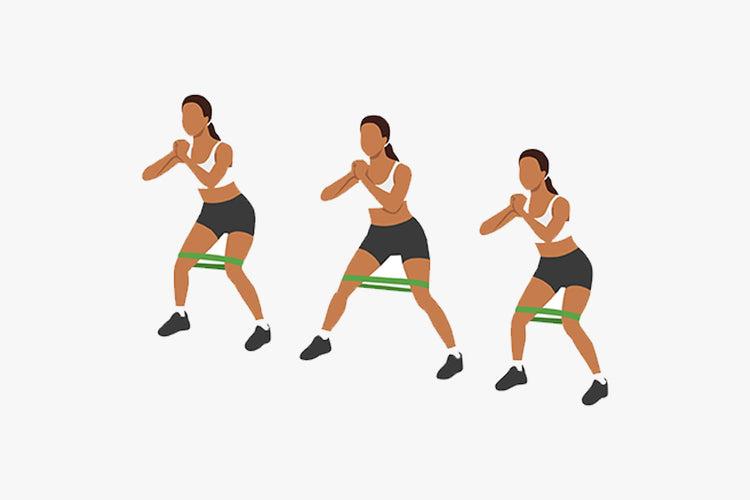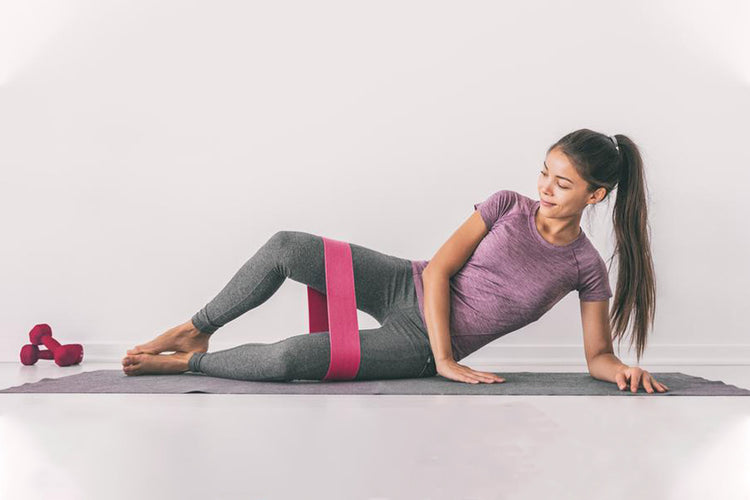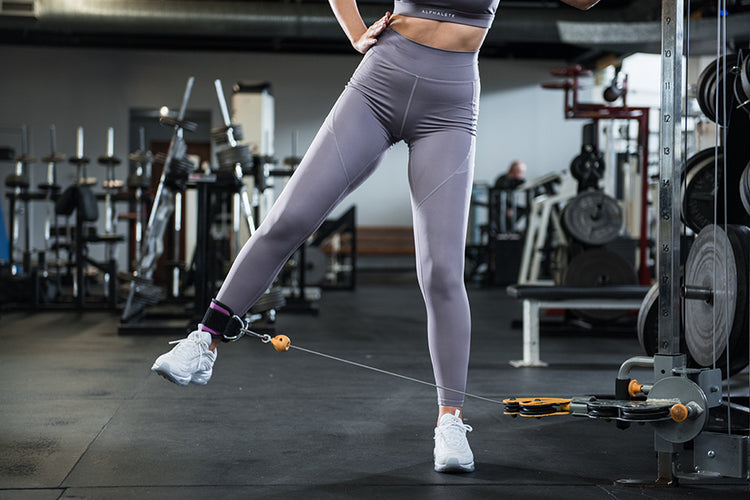To make your hips stronger and more flexible, you need to do specific exercises as part of your fitness practice. Resistance bands are a good way to improve the strength and movement of your hip flexors. These bands can be used in a lot of different ways. They offer controlled pressure that challenges your hip flexor muscles and helps them get stronger and more flexible. This article will examine six exercises for hip flexors using resistance bands.
By adding these exercises to your normal workouts, you can improve the mobility of your hips, improve the way your lower body works as a whole, and prevent common hip problems.
These workouts with bands are a great addition to your fitness routine, whether you are an athlete, a fitness fanatic, or someone who wants to eliminate hip tightness and pain. Get ready to build and move your hip flexors to make your lower body stronger and more mobile.
Hip Flexor Muscles Exercises
The muscles in our hip flexors are essential for everyday activities such as walking, running, bending, and lifting. Our muscles can become tight and weak due to prolonged sitting and a sedentary lifestyle. This can cause discomfort, limited mobility, and an increased risk of injuries.
Adding hip flexor exercises to your workout can improve your hip flexibility and strength, which can help prevent problems and promote better balance and hip function. Resistance bands are great for working out your hip flexors. They provide adjustable resistance and help you target your muscles more precisely.
The bands keep the tension steady during the exercises, making it harder for the hip flexors and helping the muscles work better. Moreover, they are adaptable and convenient, which makes them appropriate for people with varying degrees of fitness. You can gain many benefits by adding hip flexor exercises with bands to your workout routine.
These exercises can reduce hip pain and discomfort and improve hip stability, posture, and performance in different activities. These exercises are great for athletes, fitness enthusiasts, and anyone who wants to stay healthy and pain-free. They are a valuable addition to your wellness routine.
Exercise 1: Resistance Band Hip Marches for Hip Pain Relief

For relief from hip pain or discomfort, you need to include resistance band hip marches in your exercise routine. This exercise focuses on the hip flexor muscles to reduce pain and improve hip function.
Resistance band hip marches are effective and easy to do. You can use a resistance band above your ankles and do marching movements to work on your hip flexor muscles. This can help reduce discomfort and improve your mobility.
To perform resistance band hip marches, follow these steps:
- First, tie a resistance band above your ankles. Pick a band that provides enough resistance to challenge your muscles without causing any strain.
- Keep your feet apart at hip-width and engage your core while standing tall. Keep your posture correct while doing the exercise.
- Raise your knee towards your chest while keeping the band tight. Make sure you control your movement.
- Lower the raised leg and do the same movement with the other leg.
- Keep switching legs for a specific number of times, trying to maintain a smooth and consistent speed.
Hip marches using resistance bands are exercises that focus on the hip flexor muscles. This exercise is low-impact and reduces stress on the joints. It is suitable for people who have hip pain or are in the process of healing from injuries.
John Smith, a fitness expert, suggests that resistance band hip marches can be a great exercise for people with hip pain. These exercises help improve hip stability and reduce discomfort by strengthening the hip flexors. Practicing regularly can improve hip function and decrease pain during daily activities.
Start with a comfortable resistance level and increase it gradually as you become stronger and more mobile. Pay attention to your body and exercise within your capabilities, modifying the band resistance as needed.
Adding resistance band hip marches to your workout can alleviate hip discomfort and improve your hip's overall function and flexibility. To get the best results, do this exercise regularly, about two to three times every week. You can increase the number of repetitions as you get better at it.
If you have hip problems or are unsure about these exercises, it's best to talk to a healthcare professional or physiotherapist. They can offer tailored advice and adjustments to fit your requirements.
After learning about the resistance band hip marches technique and its advantages, let's proceed to the next exercise to improve your hip strength and mobility.
Related Article: Hip Circle Bands: The Coolest Way to Get Glutes You Have Always Dreamed of
Exercise 2: Resistance Band Lateral Walks for Hip and Glute Activation

Resistance band lateral walks are an excellent exercise for targeting your hips and activating your glutes. This exercise helps strengthen your hip muscles and improves your overall stability and mobility in the hip joint.
To perform resistance band lateral walks, follow these steps:
- Put a pressure band just above your knees to start. Choose a band with the right amount of pressure to work your muscles without putting too much strain on them.
- Stand with your feet about as far apart as your shoulders and with your toes pointing forward. Keep your back straight, your center engaged, and your shoulders loose.
- You should slightly bend your knees and get into a slight squat position. This will get your hips moving and get your muscles ready for the move.
- Move your right foot to the side and push against the band's pressure. Keep your knees bent throughout the workout, and keep the band tight.
- Then, bring your left foot back to where it was initially. Pay attention to keeping your movement smooth and under control.
- Step sideways, putting one foot in front of the other for a set distance or number of times. As you move, try to keep the band stretched out.
When you do lateral walks with a resistance band, you mostly work the muscles that pull the hip away from the body, like the gluteus medius and gluteus minimus. These muscles stabilize the hips and keep them in the right place when you walk, run, or jump.
By doing lateral walks with a resistance band, you add an outside force that works your muscles throughout the full range of motion. Also, lateral walks with a resistance band improve hip mobility and flexibility. As you step sideways against the band's resistance, your hip joints are pushed to work harder, improving their range of motion and making them work better.
During resistance band lateral walks, you should keep your form correct. Keep your core engaged, your back straight, and your knees aligned with your toes. Avoid letting your knees cave in or lean too far to one side.
Adding resistance band lateral walks to your workout routine is especially helpful if you play sports like basketball, soccer, or tennis that require you to move from side to side. These movements help strengthen the hip muscles and make the hips more stable. This lowers the chance of getting hurt in the hips or knees.
Resistance band lateral walks are a simple and effective exercise to include in your workout routine, whether you are an athlete, a fitness fanatic, or just want to strengthen your hips and glutes. Make sure to start with a level of resistance that is right for your current fitness level and gradually increase the difficulty as your strength grows.
DMoose Resistance Loop Bands are a great way to get in shape and reach your exercise goals. Get in shape with the help of the best exercise bands. Our resistance bands are great for all your workout needs, whether you want to get stronger or heal from an injury. With the resistance bands by DMoose, you can get your perfect body shape and build a strong core.
Our exercise bands can help you get stronger all over. This product is great for sports training because it can handle more weight and different amounts of force.
Exercise 3: Resistance Band Clamshells for Hip Strength in Runners

Resistance band clamshells target the hip abductor muscles, specifically the gluteus medius, and minimus. These muscles help keep the pelvis stable and maintain proper alignment while running. Working on these muscles can prevent the hip from moving inward too much and help maintain good running posture.
To perform resistance band clamshells, follow these steps:
- Put a resistance band above your knees and lay on your side.
- Bend your knees to about 45 degrees and make sure they align with your hips.
- Put your head on your lower arm and use your other arm to hold up your upper body before you.
- Keep your core engaged and your feet together while doing the exercise.
- Lift your top knee slowly while keeping the resistance band tight.
- Bend your knee as much as possible without twisting your hips or pelvis.
- Stop briefly at the highest point of the motion and sense the tightening in your hip muscles.
- Lower your knee slowly to the starting position.
- Do the same action multiple times before changing sides.
Concentrating on performing the movement correctly rather than completing the exercise quickly is essential. To get the best results, do clamshells with proper form and control. Doing resistance band clamshells regularly can make your hip abductors stronger, enhance hip stability, and decrease the likelihood of common running injuries such as IT band syndrome, runner's knee, and hip bursitis.
Runners need strong hips to maintain good form and avoid getting injured. Adding this exercise to your routine can improve your running performance and keep your hips healthy.
Begin with a resistance band that is challenging enough while still enabling you to maintain proper form. When you get stronger, you can use a band with more resistance. To get the most out of resistance band clamshells for hip strength in runners, it's crucial to maintain consistency and gradually increase the intensity over time.
Related Article: What Is Bursitis of the Hip? 6 Best Exercises for Hip Bursitis
Exercise 4: Hip Flexor Band Kicks for Intensified Workout
Hip flexor band kicks can be a great addition to your workout routine if you want to challenge your hip flexor muscles.
You can make your hip flexor muscles work harder by using hip flexor bands or mini bands during your workout. This workout involves your hip flexors and uses bands to provide resistance, which can help increase your strength and enhance your hip mobility.
To perform hip flexor band kicks, follow these steps:
- First, put on a hip flexor band above your ankles. Make sure it's firmly fixed.
- Place your feet at a distance equal to the width of your hips and tighten your abdominal muscles.
- Lift your leg and knee forward while keeping the band tight. Use your hip flexor muscles to lift your leg.
- Go back to the initial position and perform the same action with the opposite leg.
- Keep switching legs and do 10-15 repetitions on each leg.
Lisa Davis, a fitness expert, recommends hip flexor band kicks to enhance your hip flexor workout. The bands' resistance makes your muscles work harder, increasing strength and enhancing hip mobility. It's an excellent workout for people who want to make their workouts more intense and achieve better results.
Adding hip flexor band kicks to your workout routine can improve the efficiency of your hip flexor exercises and help you make progress in your fitness journey. Begin with a resistance band that matches your fitness level and gradually increase the resistance as you get stronger.
You can try different ways of doing hip flexor band kicks, like doing them on one leg or adding pulses at the top. These differences can make your muscles work harder and give you more advantages.
DMoose Hip Circle Bands are made to shape and tone your hips, legs, and calves so that your lower body looks perfectly toned. With these superior elastic cotton hip rings, you'll feel comfortable and safe. On the inside of these bands is a rubber that doesn't slip, so you can hold on to it even when working out hard.
Exercise 5: Resistance Band Glute Bridge for Hip Pain Management
The resistance band glute bridge is a great exercise option if you want to focus on your hip muscles and alleviate hip pain. This workout helps activate and strengthen the glute muscles while engaging the nearby hip muscles. This promotes stability and reduces discomfort.
To perform the resistance band glute bridge, follow these steps:
- Put a resistance band above your knees and lay on your back with your knees bent and feet on the ground.
- Tighten your glutes and core while keeping your back straight.
- Lift your hips off the ground by pushing through your heels. Keep tension in the band by pressing your knees outward against it.
- Stay in the bridge position and contract your glutes for a few seconds to increase their activation.
- Lower your hips slowly to the starting position and repeat for the number of repetitions you want.
This exercise becomes more challenging with the resistance band as it resists the outward movement of your knees. Resistance engages the hip muscles, such as the glutes, hip abductors, and external rotators, leading to a complete exercise routine.
The resistance band glute bridge is an excellent exercise for hip pain. It makes the glute muscles work, which helps keep the hip joints stable. Making these muscles stronger can help reduce pain, make your hips work better, and improve the stability of your hips overall.
To make it more challenging, you can attempt different versions of the resistance band glute bridge, like doing it with one leg or elevating it with a bench or step. Doing these different variations can activate your hip muscles more and let you gradually increase the difficulty as you become more powerful.
Pay attention to your body and begin with a resistance band that gives you enough resistance to push yourself but still enables you to maintain proper form and control. As you keep going, you can slowly raise the band's resistance to keep pushing your hip muscles.
Exercise 6: Resistance Band Hip Abduction for Runners

Resistance band hip abduction exercises can benefit runners who want to improve their performance and lower their chances of getting injured. This workout focuses on the hip abductor muscles. These muscles help stabilize the pelvis and keep the body in the correct position while running.
To perform resistance band hip abductions, follow these steps:
- Place a resistance band around your ankle and secure it.
- Stand straight with your feet at a distance equal to the width of your hips and tighten your abdominal muscles.
- Lift your leg to the side while keeping the band tight.
- Engage your hip abductor muscles while lifting your leg.
- Take a quick break at the highest point of the motion, sensing the tightening in your hip muscles.
- Lower the leg down slowly and return to the initial position with control.
- Do the same thing on the opposite side and keep switching legs a certain number of times.
Adding resistance band hip abductions to your workout routine can help you strengthen your hip abductor muscles and enhance your running efficiency. If your hip muscles are strong and balanced, you will move more smoothly and with better control. This can lead to better running performance.
Begin with a resistance band that is challenging enough but still lets you maintain proper form. As you keep going, you can slowly make the band harder to keep pushing your hip abductor muscles and make them even stronger.
Conclusion
Incorporating hip flexor exercises with bands into your fitness routine can significantly benefit your hip strength and mobility. These exercises target the hip flexor muscles, alleviate pain, enhance stability, and improve flexibility.
Regularly performing hip flexor exercises with bands, you can experience relief from hip pain, strengthen your hips, and enhance overall hip function. These exercises suit individuals of all fitness levels and can be tailored to meet specific needs and goals.
To maximize the benefits, aim for consistency in your practice. Include these exercises in your routine at least twice to thrice a week, gradually increasing resistance as your strength improves.
Start incorporating hip flexor exercises with bands into your workouts today and enjoy the transformative effects on your hip strength and mobility. Together, let's unlock the full potential of your hips and empower you to achieve your fitness goals.











